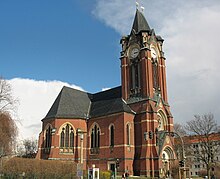Pauluskirche (Plauen)
The Pauluskirche in Plauen is an Evangelical Lutheran church that was consecrated on November 29, 1897.
Building history
The first suggestions for building a third church in Plauen go back to 1881. Lengthy negotiations between the municipality, which owned the land for the new church, and the church council delayed the start of construction by more than ten years. In 1891 an architecture competition was launched, which was won by the architect Georg Weidenbach from Leipzig . One of the driving forces behind the start of construction was Superintendent Lieschke, who, after taking office in 1892, succeeded in dividing the previously largest parish in Saxony into three smaller, independent parishes (Johannis, Luther and Paulus parishes). In 1893 the city council gave the Paulus community a larger piece of land. In 1894 the building plans were finally approved by the church.
So on June 17, 1895, after two months of preparatory work, the foundation stone was laid. The topping-out ceremony was celebrated on August 26, 1896 .
The bell of the Pauluskirche sounds in the disposition b – des′ – f′ – as ′. On November 30, 1895, the consecration of the three larger of the four cast steel bells made by the Bochumer Verein took place in b – des′ – f ′, a b minor triad. The fourth followed as a donation on July 8, 1897 and expanded the disposition to a B flat minor seventh chord. The bells ring on straight wooden yokes. All four bear an inscription taken from the letters of the Apostle Paul (see table).
|
Bell jar |
Chime |
Casting year |
Caster |
Mass (kg) |
inscription |
| 1 | b −8 | 1895 | BVG | ≈3,400 | Donated by Karl Lange and his family out of gratitude to God [as donors of the bell], the righteous will live his faith |
| 2 | des ′ −4 | 1895 | BVG | ≈2,100 | Love is the fulfillment of the law |
| 3 | f ′ +4 | 1895 | BVG | ≈1,400 | Hope does not turn into shame |
| 4th | as ′ +4 | 1897 | BVG | ≈600 | Glory to God forever [in addition, the name of the Köchel family as donor] |
Until 1918 the Pauluskirche served the 10th Royal Saxon Infantry Regiment No. 134, stationed in Plauen since 1903, as a garrison church .
During the First World War, the Pauluskirche had to surrender 59 tin organ pipes from the Jehmlich organ as a result of a confiscation for war needs. It was only in 1921 that replacements could be found for them.
In World War II
The Pauluskirche is located in the Bahnhofsviertel, the most heavily damaged district of Plauen during the air raids in World War II, with around 90% of it. The church was spared bombing raids for a long time. Only the thirteenth attack on April 10, 1945 by the British Royal Air Force led to massive damage to the exterior and the subsequent fire in the church. The roof of the nave burned out almost completely. The spire, which had been on fire for a long time, finally collapsed. All windows were completely lost, the interior was badly damaged, so that it had to be completely renewed. The Jehmlich organ was also so badly damaged that it had to be replaced. Only the altar and the pulpit were spared.
After 1945
In 1946, on the initiative of some pastors and parishioners, the reconstruction began. In 1957 the church was consecrated for the second time. The church tower was only rebuilt in a greatly shortened form.
Web links
Coordinates: 50 ° 30 ′ 8.5 ″ N , 12 ° 8 ′ 23.2 ″ E

